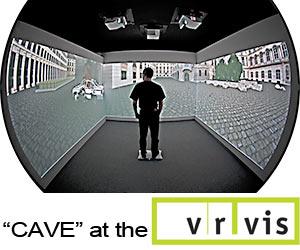News
April 2021 |
Due to current circumstances, the lecture will not be held in the usual way.Since I cannot give you access to our hardware, every student will prepare a - short - presentation with slides to a specific topic. Students who own VR hardware may present a project, the others will present a topic they choose with me at the start of the lecture.Please enroll via email, when I have your mail I can send out information as soon as I know what to do. The lecture will only be held if enough students enroll! |
|
| Introduction/Start of lecture: Room#HA0509 ("Besprechungsraum"), Favoritenstr. 9, 5. floor Since all the administrative information is dealt with in the introduction, students not attending may miss out on hardware reservations, exam info and additional topics. So be there or send a mail. SS 2.0, 186.156 VU, by arrangement Since the practical part of the lecture is limited by the available hardware resources, only a limited number of students/workgroups can be accepted. Written midterm & final exam Lecturer: Anton FuhrmannLater lectures will be held at the VRVis research center, dates by arrangement. |
Changed conditions, see above!
Examination
Written exams at midterm and end of semester.
Lab project
Additionally, you will have to finish a short VR lab project:
1-2 students per groupmust be finished within 3 monthswork@home or @VRVismay be own themesdevelopment environment: HTC Vive, Unity
General Information
This course describes devices and techniques used in Virtual Reality applications. It is intended to serve as an introduction into the practical implementation of VR and deals directly with the problems and the special circumstances in the realization of a virtual environment.
It is complemented by the course Virtual Reality in the winter term.
During this course students will gain practical experience with VR-devices and applications, like the ones depicted on the right.
Main Contents:
history of VR3D display hardware:stereo projectionauto stereoscopic displayshead-mounted displays (try our Oculus DK2!)3D input hardware:tracking (optical, magnetical, inertial, mechanical, ...)depth imaginghaptic feedback"exotic" devices: stimulate smell, balance, 3D scan...VR set-up integration specifics
Recommended prerequisites:
english reading skills (obviously)Computergraphics courseinterest in real-time graphics, virtual reality methods and hardware
Additional information:
In addition to the written exam, student will implement a simple (or even complicated, if you want) VR-application.
Teamwork is possible and will be encouraged. Students can implement their work at home, but due to the hardware-dependent nature at least part of the development has to be performed at the VRVis research center.
Attachments
| Attachment | Size |
|---|---|
| AdvancedTopicsVR_Vorlesung_2019_Displays_1.pdf | 3.27 MB |
| AdvancedTopicsVR_Vorlesung_2019_Displays_2.pdf | 1.89 MB |
| AdvancedTopicsVR_Vorlesung_2019_Tracking.pdf | 3.33 MB |
| AdvancedTopicsVR_Vorlesung_2019_Systems.pdf | 5.48 MB |
